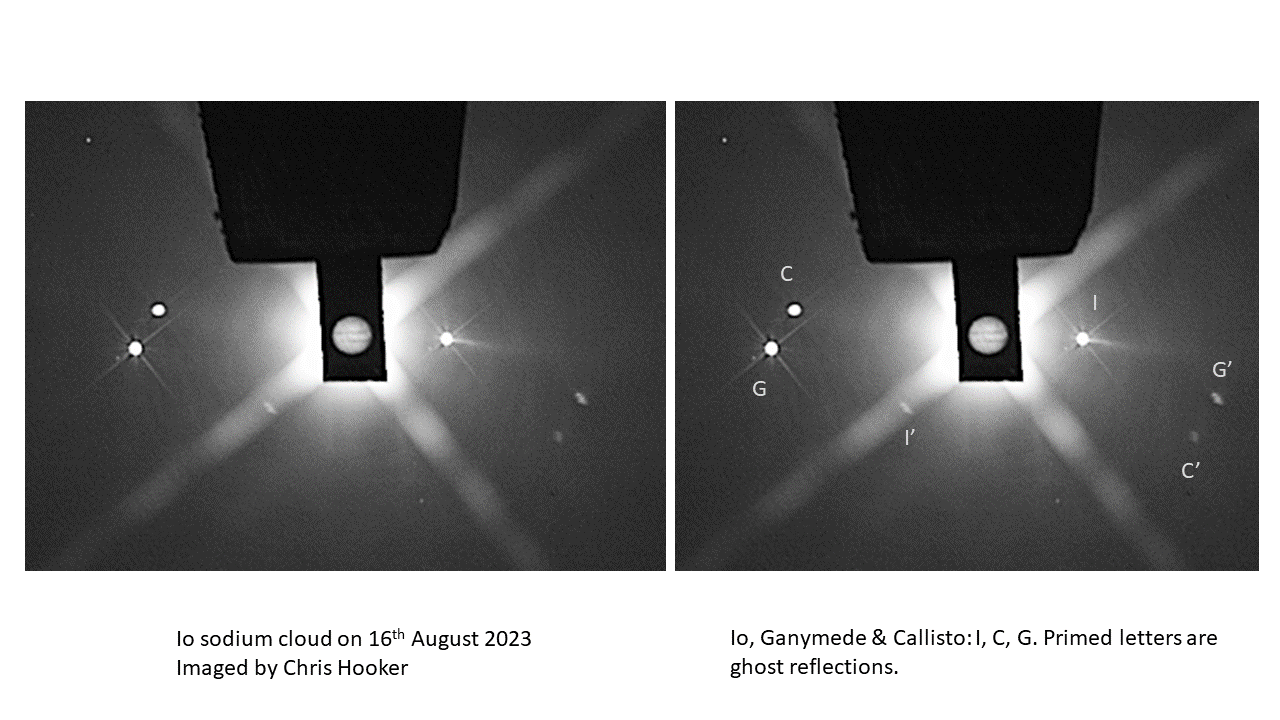2023 September 1
Imaging the sodium cloud of Io
A notable feature of the Jupiter system is a cloud of sodium atoms emitted from the satellite Io, which has always been regarded as something observable only with professional equipment. Now, BAA member Chris Hooker has produced the first amateur images of it, using just a 10-inch reflector.
The Io sodium cloud was discovered by spectroscopy in 1972, and was subsequently imaged from professional observatories; it is a permanent feature of the complex environment around Jupiter. That environment is mainly populated by plasma – ionised atoms, especially of sulphur and oxygen, which are ultimately derived from Io’s volcanoes. The ions and electrons form intense radiation belts, and particularly a plasma torus close to Io’s orbit. The sodium cloud is rather different: it is composed of neutral atoms, thought to be scoured from Io by the rushing wind of the plasma torus constantly blowing past it. These atoms probably come mainly from the thin atmosphere, perhaps supplemented from the biggest volcanic plumes and from the surface. Because the atoms are neutral, they remain in a ‘banana-shaped’ cloud that remains close to Io in its orbit, rather than being dispersed through the magnetosphere (although there is also a much fainter, much larger, more diffuse ‘sodium nebula’).
The cloud contains neutral atoms of sulphur and oxygen as well, but sodium is by far the most efficient optical emitter. Its emission in the orange ‘D line’ is well known from street lighting. Io’s cloud is not very faint, but it is normally overwhelmed by the glare of Jupiter. In the June issue of the Journal of the BAA, David Boyd described how he has been able to detect the sodium emission by spectroscopy using a medium-sized amateur telescope [ref.1].
Chris Hooker, in Oxfordshire, had already taken striking images of the comet-like sodium tail of Mercury, and he has now turned his attention to Io, using a 254 mm reflector with an Alluxa narrow-band sodium D-line filter, with Jupiter attenuated by a strip of dense neutral filter. He took the image posted here on 2023 August 16, with an ASI174MM camera, and stacked around 80 exposures totalling 15 seconds, dark-fielded and slightly sharpened. The sodium cloud appears like a jet extending from Io away from Jupiter and tilted down with respect to Io’s orbital plane. On the right is a copy identifying the visible moons and ghost reflections that are also present. He took a similar image on August 29, again clearly showing the Io cloud, and confirming that the feature was not visible beside other moons, nor in an image with a broad-band filter. (Further details accompany the images in the BAA Members’ Gallery and Jupiter Gallery.)
This achievement opens the way for possible amateur monitoring of the Io cloud. There may be variations in its jet-like appearance and its brightness, as suggested by past professional observations, so amateur imaging could document any such variations, and show whether they correlate with large volcanic eruptions detected by professional infrared imaging or by Juno.
Ref.1: Boyd, D. Journal of the BAA, 133, 142 (2023 June).
| The British Astronomical Association supports amateur astronomers around the UK and the rest of the world. Find out more about the BAA or join us. |
